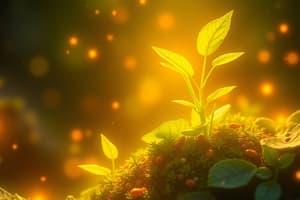Podcast
Questions and Answers
Hva er hovedfunksjonen til lysreaksjonene i fotosyntesen?
Hva er hovedfunksjonen til lysreaksjonene i fotosyntesen?
- Frigjøre oksygen til atmosfæren
- Konvertere lysenergi til kjemisk energi (correct)
- Konvertere karbondioksid til oksygen
- Bygge organiske karbonforbindelser
Hvor i kloroplasten foregår lysreaksjonene i fotosyntesen?
Hvor i kloroplasten foregår lysreaksjonene i fotosyntesen?
- Ytre membran
- Granum
- Thylakoidmembranen (correct)
- Stroma
Hva er den primære funksjonen til klorofyll i lysreaksjonene?
Hva er den primære funksjonen til klorofyll i lysreaksjonene?
- Å produsere oksygen
- Å transportere protoner
- Å eksitere ved absorpsjon av lys (correct)
- Å danne karbohydrater
Hva er hensikten med elektrontransportkjeden i lysreaksjonene?
Hva er hensikten med elektrontransportkjeden i lysreaksjonene?
Hva skaper en elektrokjemisk gradient i lysreaksjonene i fotosyntesen?
Hva skaper en elektrokjemisk gradient i lysreaksjonene i fotosyntesen?
Hva er hovedfunksjonen til klorofyll i fotosyntesen?
Hva er hovedfunksjonen til klorofyll i fotosyntesen?
Hva er ATP-syntase sin rolle i fotosyntesen?
Hva er ATP-syntase sin rolle i fotosyntesen?
Hva er hovedfunksjonen til elektrontransportkjeden i lysreaksjonene?
Hva er hovedfunksjonen til elektrontransportkjeden i lysreaksjonene?
Hva er konsekvensen av at oksygen diffunderer ut av kloroplasten under lysreaksjonene?
Hva er konsekvensen av at oksygen diffunderer ut av kloroplasten under lysreaksjonene?
Hvilken type lys absorberes av klorofyll b?
Hvilken type lys absorberes av klorofyll b?
Flashcards are hidden until you start studying
Study Notes
Photosynthesis: An Overview
Photosynthesis is the process by which living organisms, primarily green plants, convert light energy into chemical energy. It is a fundamental biological process that underpins the biosphere, providing the primary source of energy and organic carbon for almost all life on Earth.
Subtopic: Light Reactions
The light reactions of photosynthesis, also known as the light-dependent reactions, take place in the thylakoid membrane of the chloroplast. Unlike the Calvin cycle, which occurs in the stroma, the light reactions require a constant supply of light energy. The following steps summarize the main events of the light reactions:
- Absorption of Light: A photon hits the antenna pigments, triggering a cascade of events that eventually reaches the reaction center containing chlorophyll.
- Excitement of Chlorophyll: The absorption of light excites the chlorophyll molecule, kicking off a series of reactions known as the light-harvesting system.
- Formation of Electron Transport Chain: The excited electron from the chlorophyll molecule moves through an electron transport chain, which is composed of numerous pigments and proteins. This chain transports electrons from high energy to low energy levels while pumping hydrogen ions into the thylakoid interior.
- Creation of Proton Gradient: The movement of protons across the membrane creates an electrochemical gradient, known as a proton motive force or pH gradient. This force drives ATP synthesis through chemiosmosis.
- Photonoxidation Reactions: Water molecules are split into oxygen gas and protons during this process. Oxygen gas diffuses out of the chloroplast while the protons further fuel electron transport and ATP formation.
Key Players in Light Reactions
- Chlorophyll: An essential pigment that absorbs light and plays a central role in photosynthesis. Different types of chlorophyll exist, each with varying absorption spectra. Chlorophyll a and b are most abundant in plants and absorb blue and red light, respectively.
- Electron Transport Chain: A series of proteins that accept and transfer electrons along an energy gradient. These proteins play a crucial role in generating the electrochemical gradient and driving ATP synthesis.
- ATP Synthase: An enzyme that uses the energy from the proton motive force to generate ATP molecules, which are used for various cellular processes, including photosynthesis itself.
Studying That Suits You
Use AI to generate personalized quizzes and flashcards to suit your learning preferences.




